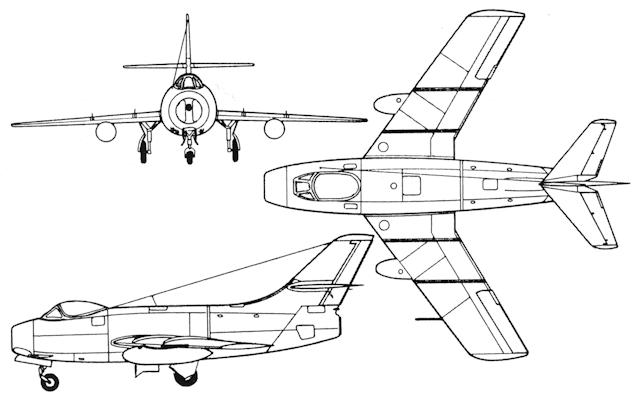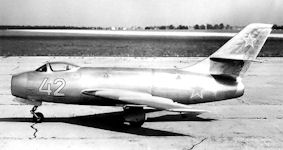YAK-30 (FIRST) fighter-interceptor
The Yakovlev OKB's response to the March 1946 requirement for a Rolls-Royce Derwent-powered Mach=0.9 "frontal" or general-purpose tactical fighter suitable for use from existing unpaved airfields was the Yak-30. Continuing the search for the most efficient design and construction of a light maneuverable tactical fighter, EDO team headed by Yakovlev, in 1948 passed the test on the plane Yak-30 (the first one with that name). Derived from the Yak-25 from which it differed primarily in having wings sweptback 35° at quarter chord, the Yak-30 retained the fuselage, tail surfaces and undercarriage of the earlier fighter fundamentally unchanged, together with the three-NR-23 cannon armament. Powered by a 1590kg RD-500 turbojet, the first of two Yak-30 prototypes was flown on 4 September 1948.
Compared with the preceding his Yak-25, the new aircraft designers for the first time in its practice applied swept wing with an angle 35° through the quarter chord. Dvuhlonzheronnoe wing area of 15.1 m2 was slotted flaps deflected by 20° during takeoff and landing 50°. To eliminate the overflow of the boundary layer at the end of the wing on the top surface of the ridges were installed - aerodynamic partitions. The main armament - three guns caliber 23 mm ammunition, 75 rounds each - was located in the forward fuselage under the cockpit. Takeoff weight fighter with a normal fuel capacity of 830 liters in the main tanks - 3330 kg. With two external fuel tanks with a total capacity of 360 liters takeoff weight reached 3650 kg.
Tests of the Yak-30, launched in September, 1948, were normal. For the first time applied the swept wing behaved quite "decent". With its fine-tuning performed in a short time, the OKB employees are widely used experience teams, led by Lavochkin and A.I.Mikoyanom that somewhat earlier applied for a similar aerodynamic configuration swept wings on fighter La-15 and MiG-15 . Performs factory test pilot S.N.Anohin well he said about the Yak-30. Fighter was quite easy to pilot, it could carry forward and reverse figures of aerobatics with the change of sign of overload. The use of a swept wing allowed during the test, as they say, "pure" to reveal its impact on the flight characteristics of the machine. In the land of the Yak-30 showed a maximum speed of 930 km / h - 20 km / h in less than Orthoptera Yak-25. But with an increase in altitude convincingly evident advantage of the wing arrow shaped. At an altitude of 5500 m the aircraft reached a speed of 1010 km / h - 45 km / h more than the developed his predecessor, and 10 thousand meters of flying at a speed of 970 km / h. - 60 km / h faster than the Yak-25. Best of the Yak-30 was and climb, height of 5 thousand. Meters he gained for 2.2 minutes. Swept wing virtually no impact on the ceiling, range and duration of flight fighter. However, the time of turn and landing speed with swept wings slightly increased, respectively, and increased run length.
Tests had shown that the new fighter with swept wings in many ways superior to its predecessor. At the beginning of 1949, the OKB was built an improved version of the fighter - the Yak-30D with an improved wing root, in the design of which has been introduced and the so-called "internal brace", set the air brake. The Yak-30D was also fitted with air brakes on the aft fuselage. Normal loaded weight (without external fuel) was increased by 110kg. The second prototype, the Yak-30D, which joined the flight test program early in 1949, had a 38cm section inserted in the aft fuselage, revised mainwheel doors forming a large section of the fuselage skinning, Fowler-type flaps in place of split flaps, increased fuel and ammunition capacity, and changes to the oxygen system and radio equipment. Slotted flaps replaced by a retractable, increased the supply of fuel and ammunition. In another Yak-30D put together powerplant, made changes in oxygen and radio equipment. As a result of innovations fighter takeoff weight increased to the normal refueling up to 3440 kg; with drop tanks - up to 4015 kg. Maximum Yak-30D speed at sea level reached 1025 km / h, range - 1950 km.
However, by 1949 the characteristics have not improved Yak-30 meet increasing demand for easy front-line fighters. Although the modifications introduced by the Yak-30D eradicated several shortcomings displayed by the first prototype, the first production deliveries of the superior MiG-15 were already taking place by the time that the improved version of the Yakovlev fighter entered flight test, and the results of NIl V-VS trials were, therefore, little more than academic. Therefore, the Yak-30 and Yak-30D were only prototypes.

|
NEWSLETTER
|
| Join the GlobalSecurity.org mailing list |
|
|
|


